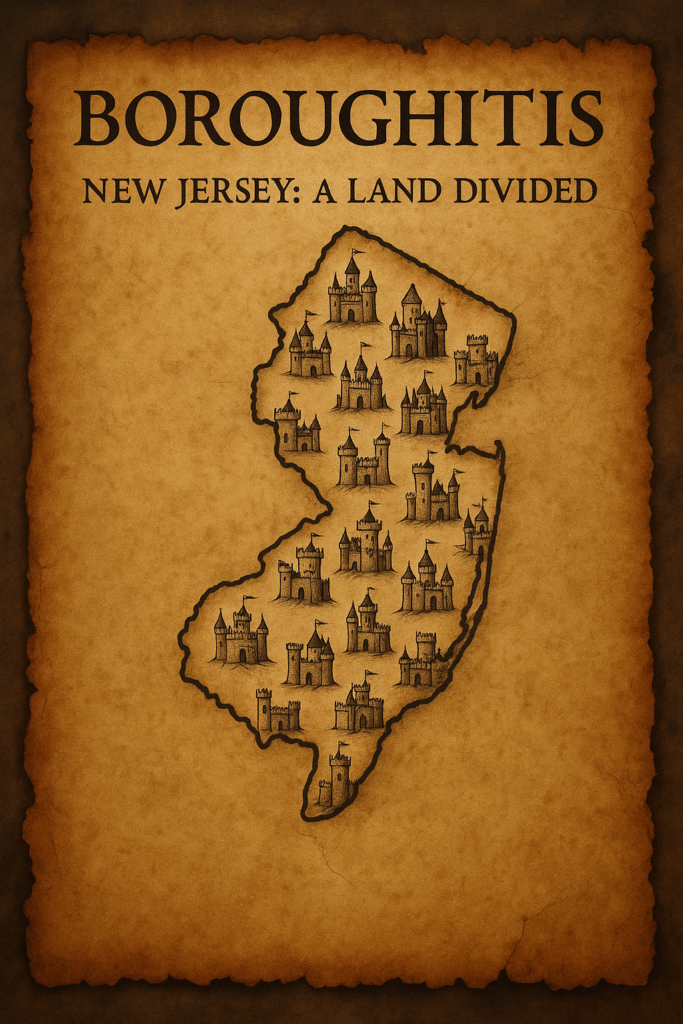
Why Does New Jersey Have So Many Towns? 🏘️
New Jersey is just 8,722 square miles, smaller than many counties in the U.S., yet it has over 560 municipalities. Some are barely a square mile in size, but still have their own mayor, council, police department, school district, and public works crews.
Take Emerson, for example. It is about 1 square mile, has a population of roughly 7,500, its own high school, police department, and municipal government. Emerson residents are proud of their town, but all of those independent services cost money and that cost shows up on their property tax bills.
So how did New Jersey end up with this patchwork of tiny, self-governing boroughs? The answer is a little-known chapter of state history called boroughitis. While it happened over 100 years ago, its effects are still draining homeowners’ wallets today.
The Birth of Boroughitis 📜
The term “boroughitis” refers to the explosion of new boroughs in New Jersey during the 1890s, especially 1894 and 1895. Before that, New Jersey’s government structure was dominated by large townships. A perfect storm of political and social changes set the stage for a municipal breakup.
In the late 1800s, railroad lines were expanding into rural areas, and wealthy New Yorkers were moving into commuter suburbs in places like Bergen County. These newer residents often had different priorities than the long-time farming communities they joined. They wanted better schools, more local control, and services tailored to their suburban lifestyle.
A little-known state law allowed a portion of a township to break away and form its own borough via referendum. In 1894, the legislature made it even easier and more politically advantageous to create a borough. The new law gave each borough its own representative on the county Board of Chosen Freeholders, and another law that year consolidated school districts, which made controlling your own district a big incentive to split off.
The result was nearly 40 new boroughs formed in just two years, many of them in Bergen County. For example:
- Ridgefield Township was carved into towns like Bogota, Leonia, and Ridgefield Park.
- Maywood broke away from Midland Township (now Rochelle Park and other towns).
- Emerson, Oradell, Harrington Park, and dozens of others emerged during or after this borough boom.
It was local self-determination at its peak, but it also created a long-term financial problem.
How Boroughitis Still Impacts New Jersey Today 💰
Boroughitis left New Jersey with one of the most fragmented municipal systems in the country. This means duplication of services across hundreds of small towns.
Every borough, no matter how small, needs:
- A mayor and council (with salaries, benefits, and staff)
- A police department (salaries, benefits, pensions, vehicles, equipment)
- A Department of Public Works (trucks, plows, road crews)
- Administrative offices (clerk, tax assessor, building department)
In larger states, many of these services are shared by a county or a regional authority. In New Jersey, they are repeated hundreds of times and homeowners foot the bill.
Example: Emerson’s police department serves about 7,500 residents. Compare that to towns in other states where one department serves 50,000 or more people. The cost per household is significantly higher in Emerson because it is spread across fewer taxpayers.
Property taxes reflect this duplication. A home in Maywood, with an average tax bill over $11,000, can sit just blocks from Paramus, where taxes are significantly lower thanks in part to Paramus’s robust commercial tax base. The homes may be similar, but the municipal line makes a big difference in the annual cost of ownership.
The Impact on Homeowners 🏡
High property taxes affect homeowners in two major ways: affordability and resale value.
For buyers, a $12,000 annual property tax bill can knock tens of thousands off what they can afford in purchase price. That means fewer qualified buyers for homes in higher-tax towns.
For sellers, a high tax bill can slow down the sale or require pricing more competitively to attract offers.
In some cases, borough borders create noticeable value differences between otherwise similar homes:
- Emerson vs. Oradell: Both are small, desirable Bergen County towns with good schools. Differences in tax rates, amenities, and perception can still impact pricing.
- Maywood vs. Hackensack: Two homes with the same square footage and updates can carry drastically different tax burdens simply because they are on opposite sides of the street.
Small-town pride is strong. Emerson’s decision to maintain its own high school is a point of community identity. However, it also means bearing the full cost of facilities, staffing, and programs without the economies of scale that larger districts enjoy.
Could Consolidation Be the Answer? 🤔
Over the years, some have suggested consolidating services or even merging municipalities to cut costs. Shared services like regionalizing police, fire, or public works could reduce overhead.
For example, Emerson has explored shared emergency dispatch with neighboring towns, and other Bergen County boroughs have looked into joint DPW or school programs.
Consolidation faces political and cultural resistance. Many residents value the intimacy and control of small-town government. They like knowing their mayor personally or feeling that their police chief is just a phone call away. Local identity runs deep in New Jersey, and giving up a borough’s independence can feel like a loss of heritage.
Still, studies have shown that merging towns or services could save millions statewide, potentially lowering property taxes without sacrificing quality of life.
What This Means for Buyers and Sellers 📊
If you are buying:
- Compare annual taxes, not just the list price. A home with a lower asking price in a high-tax borough could still cost more to own each month than a slightly pricier home in a lower-tax town.
- Consider the value of services. Does the borough offer exceptional schools, recreation programs, or public safety that justify the higher taxes?
If you are selling:
- Highlight the unique benefits of your borough such as strong community programs, responsive local government, walkable downtowns, and neighborhood pride.
- Work with a real estate agent who understands the nuances of Bergen County’s boroughs and can position your home to the right buyers.
Conclusion: Boroughitis Is Here to Stay — But You Can Work Around It ✅
Boroughitis may have been born out of 1890s politics, but its financial impact is alive and well. Every time you open your property tax bill, you are paying for a decision made more than a century ago to keep New Jersey’s towns small and independent.
For some, that is a price worth paying for community identity. For others, it is a frustration that makes homeownership in New Jersey harder to afford.
If you are thinking of buying or selling in Bergen County, especially in smaller boroughs like Emerson, Maywood, Harrington Park, or Bogota, you need a strategy that accounts for the tax impact and municipal services.
📞 Call or text 201-214-1349 to talk about how borough lines and property taxes could affect your next move.

